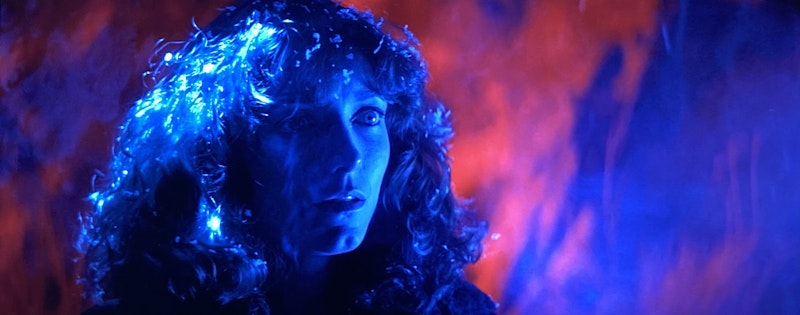"If The Thing had been a hit, my career would have been different. I wouldn't have had to make the choices that I made. But I needed a job. I'm not saying I hate the movies I did. I loved making Christine and Starman and Big Trouble in Little China, all those films. But my career would have been different.”
On the surface, John Carpenter’s assessment of his own work is pretty depressing. But it’s easy to forget that The Thing didn’t rule the summer of 1982—it was up against E.T.: The Extra Terrestrial—and besides a piddling commercial performance, it got vicious reviews. Darkness and death were out of vogue. Even Stanley Kubrick and The Shining were similarly scoffed at, and like The Thing, it was a classic by the end of the decade. But Kubrick, an older filmmaker with more work behind him, could sustain that blow. Carpenter never got out of the realm of the cult director, and though he’s perhaps the most commercially successful of them all, he’s still a big fish in a small pond. For someone who almost made it even just a bit higher, his attitude is understandable.
Starman is another genre film, one that Carpenter didn’t write or score, like most his most beloved and successful movies: Halloween, Escape from New York, They Live—but it’s far from hack work-for-hire. I believe Carpenter when he says he loves his mid-1980s movies, and although he “needed a job,” he still got $5 million more than the $19.5 million he had on The Thing just two years earlier. Starman also barely made back its money domestically, and though it kept his head above water, Carpenter remained in the genre outhouse for the rest of his career. Whether he would’ve continued to express himself through science fiction and horror, or through a Western like he always wanted, we’ll never know: he wasn’t allowed upstairs anymore.
A new 70mm print of Starman is touring the country right now, most recently in Chicago at the Music Box. The film looks extraordinary, and its high concept, along with Karen Allen’s career performance, is enough to sustain a thoroughly pedestrian but serviceable script. Allen plays Jenny Hayden, recently widowed by her late husband Scott (Jeff Bridges). At the beginning of the film, a capsule lands near her house as she’s watching 8mm home movies of them together, alive, and Scott reappears after morphing from a slimy glob into a man—a Starman. Bridges is a decent actor, but his range is limited, and like in so many other pre-Lebowski roles, he’s just not believable here—as an alien, a lover, or a foreigner. He’s too affable and technically limited to do anything other than make funny faces. He’s not even believable in long shot. Arnold Schwarzenegger is the comparison here, and his nonpareil performance as The Terminator the same year throws Bridges’ Starman under the treads.
But Bridges’ “Starman” never has to be violent or cruel, and when Jenny asks if she’s going to die, he reassures her, “I mean you no harm, Jenny Hayden.” After some coaxing, Starman convinces Jenny to go to a crater so he can meet back up with his people again. Naturally, the government isn’t thrilled and tries to kill them as they travel across the Southwest. Unlike James Cameron’s The Terminator, a superb action movie, Starman is a love story anchored by Allen and Allen alone: unlike other Carpenter films, the nasty bureaucrats are given less screen time, and in the end they fail. Jack Nitzsche’s score is ethereal and gorgeous, nothing like the ominous pounding of so much sci-fi made then and now. The particulars of Starman’s race are never dealt with, and besides a few notes about humanity (“You are a very strange species. Not like any other. And there are many, many intelligent species out there”), he’s mostly a kind mute, the benign Terminator that wants to learn from and love Jenny Hayden—that’s his mission.
Free of funky exposition, Starman is one of the most intimate movies of the 1980s, despite containing spaceships, exploding tanker trucks, dozens of helicopters, and a mountainside gunfight. Allen’s driven by nothing more than the love for her dead husband, the avatar this alien knew to take on so she would help him. She tries a couple of times to escape, but continually charmed by his naivete and kindness, she stays with him and keeps driving to the crater. “Grief,” “trauma,” and “loss” are all buzzwords right now and most films that set out to “deal with” one or more of those impossibly broad topics inevitably fall short or, at best, come in far too on the nose. Starman, a commercial exercise in Hollywood filmmaking, is a far more elegant and graceful story of grief and “love persevering.” It looks extraordinary as well, with so many practical effects, real explosions and sets, and a mind for lighting and design beyond what can be “solved” with a green screen and an Avid console.
Exploding helicopters may be out of reach for most film budgets in America in 2022, but would it kill you to have some interesting lights? Or any lights at all? Like I wrote in my review of Top Gun: Maverick, close-ups are shrouded in darkness when they shouldn’t be in packed auditoriums. Starman has close-ups, like the one pictured above, that belong in museums. You don’t need to shoot on film to make beautiful images.
—Follow Nicky Smith on Twitter: @nickyotissmith

